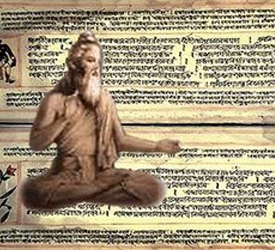Truth can not be suppressed and always is the ultimate victor.

Vedic Concepts
Veda is divided into four major parts viz, Samhitas (prayers), Brahmanas (rituals), Aranyakas ( meditations) and Upanishads (The knowledge of self). The first three (Samhita, Brahmana & Aranyaka) are collectively called as Veda Purva (Starting) and the last one Upanishad is called as Veda Anta (ending) or Vedanta. The Veda Purva is also referred as Karma Kanda (Portion dealing with Rituals & Activities) and Vedanta as Jnana Kanda (Portion dealing with The Knowledge of Supreme Self).
Vedangas
Vedas is a set of Holy books that is the most authoritative sacred / religious book for the Hindus.
Vedangas are auxiliaries of Vedas. Vedangas form an important component in comprehending and utilizing the Vedic sounds and syllables. That is the reason why Vedangas form the most important part in the study of Vedas. Vedangas are six in number. They are Siksa or euphony and pronunciation, Vyakarana or grammar, Chandas or metre, Nirukta or etymology, Jyotiṣa or astronomy and Kalpa or procedure. Each of these six is perceived of as an organ or anga of Vedas and hence the name Vedangas.
Siksa, the first of the Vedangas, deals with the rules of the phonetics or euphony. Siksa is perceived as nose of the Vedas. Just like our nose helps us in breathing and in turn sustaining life force, Siksa is the life breath of Veda mantras. Veda mantras have to be pronounced and recited properly to get the desired effects. In this respect, Siksa that lays down the rules of syllable and tonal purity gains importance. For even a small change in the Vedic sound leads to undesirable and sometimes even adverse results. For this reason alone, Siksa is considered the most important of the six angas or organs of the Veda Purusha. The Vedic Phonetics or Siksa explains how the sound of each syllable should be produced, how high or low should the pitch be and how long should it last. It is universally agreed that the Vedic sounds should not be changed. However, we see the difference in the style and pronunciation of mantras in chanting of them in different sakhas or branches. It is here that Siksa plays a very important role by settling the changes according to certain set rules for different sakhas and regions.
Vyakarana, the second of the Vedangas, deals with grammar. It is perceived as the mouth of the Vedas. Sound is the most important of the perceived forms of the Supreme Being. Vyakarana, along with Siksa, helps us in refining and clarifying those sound forms and make them as means for our well being. Unlike other grammar rules, Vyakarana aims at a much bigger picture and propounds ways to salvation and one of them is Ṣabda Brahma Vada, the theory that the sound and the Ultimate are inter linked. One of the offshoots of this theory is Nada Brahma Upasana practice where melody culminates in the Ultimate. Panini’s work is most famous of all the Vyakarana works.
Chandas or metre is the third Vedanga. It is perceived as the feet of the Vedas. Chandas lays down the rules of metrical composition. While Siksa ensures correct pronunciation and Vyakarana ensures correctness of the akṣaras or the syllables, Chandas ensures that the form of the Vedic sound does not get altered or changed. In this sense, Chandas functions as a major component in the preservation of Vedic sounds and mantras. Just as wrong pronunciation can lead to adverse results in respect of Veda mantras, omission and commission of syllables can also lead to similar effect. Therefore, Chandas is also a very important part of Vedic study. Pingala’s Chanda Sastra is the most famous of all the works in Chandas.
Nirukta or etymology is the fourth Vedanga. It is perceived to be the ear of Vedas. Nirukta is a Vedic etymological dictionary. Like any other etymology of a language, Nirukta also traces the origin of each word. But unlike other languages, Vedic language has many uncommon and difficult words to decipher. Nirukta not only delineates the origin and meaning of these words, but even in the case of common words it demonstrates by breaking the word and mapping the origin, why that particular word is used in a particular context. So, Nirukta helps a student of Vedas to understand the deeper meaning of the mantras thereby enabling him/her to grasp the metaphysical content conveyed merely by a few words or a pithy sentence. The ancient grammarian Yaska is the famous proponent of Nirukta.
Jyotiṣa or astronomy is the fifth Vedanga. It is perceived to be the eye of the Vedas. Jyotiṣa is also known by the name Nayanam, hence it is considered as the eye. There are numerous injunctions as to the time when certain planets are in certain positions and at that time one should perform Vedic rites. Hence, Jyotiṣa is a very useful part of the Vedic study. Since monitoring such far off objects like the stars and planets require complex calculations, mathematics is inevitably a part of this Śastra. For this purpose, this science is divided into three parts or skandas, namely, SiddhantaSkanda, Saṁhita Skanda and HoraSkanda. SiddhantaSkanda deals with mathematical subjects like algebra, trigonometry, geometry and arithmetic. Saṁhita Skanda deals with astronomy and astrology. HoraSkanda deals with the effects of planetary movements on earth and her subjects.
Kalpa or procedure is the sixth and the last of the Vedangas. It is perceived as the arm of the Vedas. Though technically Kalpa is meant to induct a person into all Vedic action, it tells us how to lead to good and virtuous life, how each person in different stations of life in a society should conduct oneself, what kind of activities should take place in one’s home, how to do Vedic rituals, etc. As the subject is vast, lot many sages have compiled the Śastras that fall under Kalpa. They are broadly divided into three categories, namely, DharmaSūtras, GrihyaSūtras and SrautaSūtras.
